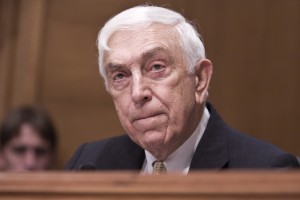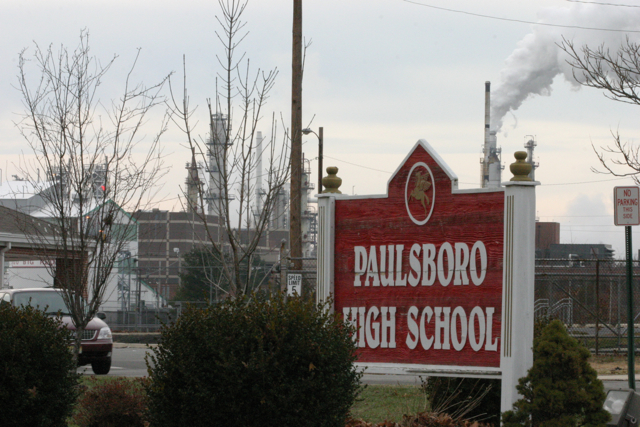Parents Want to Know: Why the News Blackout of This Story?
 NJ’s senior Senator, Frank Lautenberg, is not known to be shy when it comes to issuing press releases and generating press touting his legislative accomplishments for the people of New Jersey.
NJ’s senior Senator, Frank Lautenberg, is not known to be shy when it comes to issuing press releases and generating press touting his legislative accomplishments for the people of New Jersey.
So, I found it odd that I never saw news coverage of groundbreaking amendments he sponsored creating “Healthy, High Performance Schools.” (see “In Harm’s Way“)
For the first time, that law puts EPA in the role of developing school siting and regulatory guidelines to protect children’s health from environmental pollution while at school.
As experience throughout NJ has shown, this is a highly controversial issue.
But, curiously, I had to do a lot of Googling to find anything about the Lautenberg amendments, and finally found it reported by the small trade journal Education Week on January 16, 2008:
“Tucked quietly into the federal Energy Independence and Security Act of 2007 is a section that calls for establishing voluntary environmental-health and -safety guidelines for states to consult when locating and constructing schools, and authorizes grants for states to develop programs around those standards.
The measure, which President Bush signed into law last month, marks the first time that a federal agency [EPA] will provide such guidance.”
Given several highly controversial school exposure cases reported across NJ (at schools in Paramus, Kiddie Kollege, Union, Franklin, Garfield, Camden, etc).
I circulated the Education Week article to the NJ press corps in order to give NJ’s parents information about this issue.
Strangely, Lautenberg’s office initially denied enactment of the bill I described. After providing the text of the bill to reporters, Lautenberg’s office ran away from their own law and had no comment, thus the press had no story. Thus parents had no awareness of what was going on at EPA or NJ DEP.

EPA Administraor Lisa Jackson faced criticism for her handling of toxic school and day care cases while NJ DEP Commissioner. US Senate Environment Committee Chairwoman Barbara Boxer critically probed Jackson’s record during confirmation hearing.
The 2008 Lautenberg amendments require:
SEC. 502. MODEL GUIDELINES FOR SITING OF SCHOOL FACILITIES.
Not later than 18 months after the date of enactment of
this section, the [EPA] Administrator, in consultation with the Secretary of Education and the Secretary of Health and Human Services, shall issue voluntary school site selection guidelines that account for (1) the special vulnerability of children to hazardous substances or pollution exposures in any case in which the potential for contamination at a potential school site exists; (link to full text)
The new law was enacted in January 2008, so the EPA siting guidelines were due in June of 2009.
So, it is a good time for NJ press corp to ask EPA about the status of those guidelines. Has EPA adopted them? Here’s what I could find from EPA, which does not inspire confidence:
What is NJ DEP doing to implement them?
What are local school districts doing to detect any problems and protect children?
Why do we continue to find problems like this?
The Lautenberg sponsored federal law parallels a NJ law and NJ State programs.
For example, NJ Inspector General Cooper’s Report found that the mismanaged NJ Schools Construction Corporation – later abolished – had purchased contaminated toxic land for schools – including a federal Superfund site in Gloucester City and a radioactive former Manhattan Project in Union City site.
Governor Corzine’s SCC reforms were criticized harshly for failure to address these school siting, toxic land acquisition, indoor air, and cleanup problems.
In January 2007, Governor Corzine signed into law new requirements to set indoor air standards at schools and daycare centers. (P.L. 2007, c.1)
The bill was a response to the Kiddie Kollege tragedy, where toddlers were poisoned by mercury at a day care center that previously was a former mercury manufacturing facility under an un-enforced DEP toxic site cleanup Order.
The most complex and controversial requirements of the new law mandate that DHS and DEP take specific regulatory actions – both DEP and DHSS have failed to do so and are not in compliance with the Act.
This inaction also could affect NJ’s ability to secure grants under the Lautenberg amendments cited above:

NJ Governor Jon Corzine signed the “Kiddie Kollege” law in January 2007. “This bill will help identify and remediate educational facilities and child care centers located on environmentally high risk sites,” Governor Corzine said. “This puts New Jersey at the forefront of states nationally in protecting children from environmental contaminants while at child care facilities and schools.” (full release here)
“1. a. Within 12 months after the effective date of this act, the Department of Health and Senior Services shall adopt rules and regulations …The rules and regulations adopted pursuant to this subsection shall be protective of the health of children and infants, and shall account for the difference in rate of the absorption, metabolism, and excretion of compounds between adults and infants and children.
[…]
b. (1) No construction permit shall be issued for the construction or alteration of any building or structure to be used as a child care center licensed pursuant to the provisions of P.L.1983, c.492, or for educational purposes, on a site that was previously used for industrial, storage, or high hazard purposes, as a nail salon, dry cleaning facility, or gasoline station, or on a contaminated site, on a site on which there is suspected contamination, or on an industrial site that is subject to the provisions of the “Industrial Site Recovery Act,” P.L.1983, c.330 (C.13:1K-6 et al.), except after submission by the applicant to the construction official of documentation sufficient to establish that the Department of Environmental Protection has approved a remedial action workplan for the entire site or that the site has been remediated consistent with the remediation standards and other remediation requirements established pursuant to section 35 of P.L.1993, c.139 (C.58:10B-12) and a no further action letter has been issued by the Department of Environmental Protection for the entire site. (link to full text)
We”ve just seen another children’s toxic exposure disaster repeated in Atlantic Highlands Elementary School, where about 100 parents turned out on Tuesday night to win a major victory. (read here). Yet, that too received no press.
What the hell is going on?
Parents of thousands of kids in scores of potentially poisoned schools want to know.
Could the silence be due to a rumored NJ Attorney General’s opinion that guts the Corzine Kiddie Kollege law by an interpretation that is does NOT to apply to existing schools? (and only new school construction)?
We’ll keep you posted at Wolfenotes.com

Valero oil refinery dwarfs Paulsboro High School. Valero’s refinery emits thousands of pounds of toxic chemicals to the local air. Major upsets have coated buildings in toxic fallout. Would you send you child to this school?